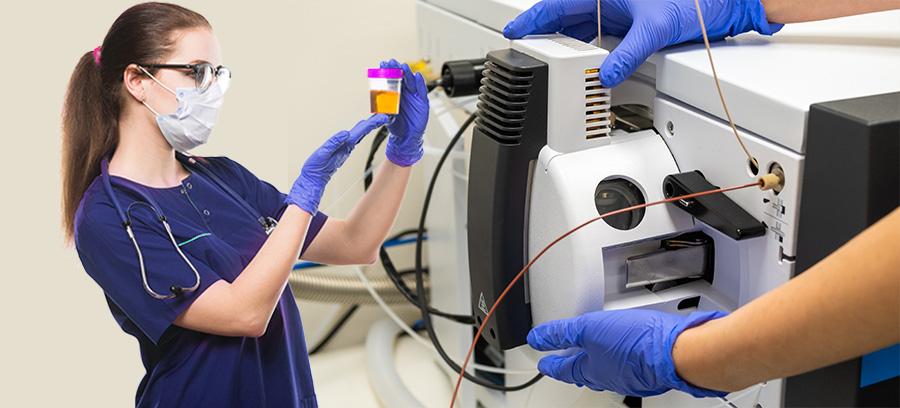Clinical toxicology has a wide range of practical and clinical applications. Rapid detection of compounds contained within known drugs of abuse (DOA) is essential in bedside practice where swift identification of the offending substance influences clinical decision-making and the choice of therapeutic interventions. Moreover, drugs with a known narrow therapeutic index, such as immunosuppressive and chemotherapy agents, need to be monitored routinely to reduce toxic side effects and ensure that the dosage of said drugs stays within an effective therapeutic range[1].
Tools used for this detection include point-of-care (POC) rapid tests which use specimens such as urine and saliva and more often than not provide qualitative results (i.e. determining whether a metabolite is present or absent in the sample); another tool used is liquid chromatography-mass spectrometry (LCMS) techniques, which provide more quantitative results and are thus essential in therapeutic drug monitoring (TDM) applications.
Point-of-care rapid testing for drugs of abuse (DOA) usually involves the use of immunoassay tests that collect a body fluid sample (e.g. urine or saliva) that is immediately added to the testing cartridge or mixed with a buffer before adding to the immunoassay strip[2]. These rapid tests, depending on the manufacturer and device used, may be able to test for multiple classes of drugs such as cannabis, opiates, benzodiazepines, and methamphetamines in one sample[3]. These rapid tests can even exist as mobile or portable platforms which enables their use in law enforcement applications[2]. Their rapid turnaround times, relatively cheaper costs, and adequate accuracy in determining the presence of DOA in a patient make them invaluable in acute care settings, where speedy diagnoses and determination of offending agents are crucial in the management of acute intoxication and overdose cases[4]. However, limitations to these rapid tests include lower sensitivity than lab testing, relatively high cut-off levels for positive results, and external factors that may affect results such as temperature, humidity, and non-standardized collection of samples[5]. Thus, confirmation of rapid test results using highly sensitive and specific liquid chromatography-tandem mass spectrometry (LCMS) techniques, along with extensive patient history-taking and physical examination, remains to be the standard of care in detecting DOA in patients[6].
Therapeutic drug monitoring (TDM) is essential to find the right balance between giving sufficient clinical medication to get the desired clinical effect and minimizing its use to limit systemic toxicity[7]. LCMS techniques are oftentimes considered the gold standard in TDM due to their high sensitivity and specificity[8]. However, barriers to the full adoption of these techniques include high initial purchase and maintenance costs, invasive sampling techniques requiring blood and/or plasma, and the need for extensively-trained specialized staff[9]. TDM for drugs with a narrow therapeutic index requires the ability to measure very low concentrations of the target compound/metabolites with low acceptable analytical imprecision rates of <10%; this results in increased turnaround times and limited applications in bedside clinical practice, therefore restricting their use in centralized laboratories[10]. LCMS techniques utilizing other matrices such as saliva, urine, and hair samples may increase patient compliance through simplified sampling methods and faster result generation, which provide an exciting future in bringing point-of-care TDM for high-acuity settings[11]. Detection of illicit drug use and therapeutic drug monitoring remains to be a challenge to physicians that cater to emergent intoxication and overdose situations and patients with a need for routine drug monitoring. Rapid point-of-care tests and LCMS techniques provide clinicians with tools to ensure faster diagnosis and thorough monitoring of pharmaceutic agents. These diagnostic methods paint a more comprehensive clinical picture that directs physician action, enhances therapeutic effectiveness, and ultimately results in better clinical outcomes and patient satisfaction.
References
- Taddeo A, Prim D, Bojescu ED, Segura JM, Pfeifer ME. Point-of-Care Therapeutic Drug Monitoring for Precision Dosing of Immunosuppressive Drugs. J Appl Lab Med. 2020;5(4):738-761. doi:10.1093/jalm/jfaa067
- Van der Linden G., Wille S.M., Ramírez-Fernandez M., Verstraete A., Samyn N. Roadside drug testing: Comparison of two legal approaches in Belgium. Forensic Sci. Int. 2015;249:148–155.
doi: 10.1016/j.forsciint.2015.01.034. - Crouch D.J., Walsh J.M., Cangianelli L., Quintela O. Laboratory evaluation and field application of roadside oral fluid collectors and drug testing devices. Ther. Drug Monit. 2008;30:188–195.
doi: 10.1097/FTD.0b013e3181679249. - Hackl G. Akute Intoxikationen: Marker für Screening, Diagnose und Therapiesteuerung [Acute intoxications: markers for screening, diagnosis and therapy monitoring]. Med Klin Intensivmed Notfmed. 2019;114(4):302-312. doi:10.1007/s00063-019-0566-7
- Vanstechelman S., Isalberti C., van der Linden T., Pil K., Legrand S.-A., Verstraete A.G. Analytical evaluation of four on-site oral fluid drug testing devices. J. Anal. Toxicol. 2012;36:136–140.
doi: 10.1093/jat/bkr016. - Soichot M, Julliand S, Filatriau J, et al. Diagnosis of Heroin Overdose in an 8-Year-Old Boy: Reliable Contribution of Toxicological Investigations. J Anal Toxicol. 2018;42(4):255-264. doi:10.1093/jat/bkx111
- Freudenberger K, Hilbig U, Gauglitz G. Recent advances in therapeutic drug monitoring of immunosuppressive drugs. TrAC Trends Anal Chem. 2016;79:257–68.
- Zhang Y, Zhang R. Recent advances in analytical methods for the therapeutic drug monitoring of immunosuppressive drugs. Drug Test Anal 2018;10:81–94.
- Shipkova M, Valbuena H. Liquid chromatography tandem mass spectrometry for therapeutic drug monitoring of immunosuppressive drugs: achievements, lessons and open issues. TrAC Trends Anal Chem 2016;84:23–33.
- Seger C, Shipkova M, Christians U, Billaud EM, Wang P, Holt DW, et al. Assuring the proper analytical performance of measurement procedures for immunosuppressive drug concentrations in clinical practice: recommendations of the International Association of Therapeutic Drug Monitoring and Clinical Toxicology Immunosuppressive Drug Scientific Committee. Ther Drug Monit 2016;38: 170–89.
- Avataneo V, D’Avolio A, Cusato J, Cantù M, De Nicolò A. LC-MS application for therapeutic drug monitoring in alternative matrices. J Pharm Biomed Anal. 2019;166:40-51. doi:10.1016/j.jpba.2018.12.040


